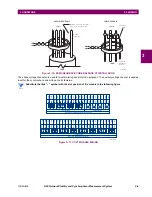
3-10
N60 Network Stability and Synchrophasor Measurement System
GE Multilin
3.2 WIRING
3 HARDWARE
3
3.2.5 CONTACT INPUTS AND OUTPUTS
Every digital input/output module has 24 terminal connections. They are arranged as three terminals per row, with eight
rows in total. A given row of three terminals may be used for the outputs of one relay. For example, for form-C relay outputs,
the terminals connect to the normally open (NO), normally closed (NC), and common contacts of the relay. For a form-A
output, there are options of using current or voltage detection for feature supervision, depending on the module ordered.
The terminal configuration for contact inputs is different for the two applications.
The digital inputs are grouped with a common return. The N60 has two versions of grouping: four inputs per common return
and two inputs per common return. When a digital input/output module is ordered, four inputs per common is used. The four
inputs per common allows for high-density inputs in combination with outputs, with a compromise of four inputs sharing one
common. If the inputs must be isolated per row, then two inputs per common return should be selected (4D module).
The tables and diagrams on the following pages illustrate the module types (6A, etc.) and contact arrangements that may
be ordered for the relay. Since an entire row is used for a single contact output, the name is assigned using the module slot
position and row number. However, since there are two contact inputs per row, these names are assigned by module slot
position, row number, and column position.
Some form-A / solid-state relay outputs include circuits to monitor the DC voltage across the output contact when it is open,
and the DC current through the output contact when it is closed. Each of the monitors contains a level detector whose out-
put is set to logic “On = 1” when the current in the circuit is above the threshold setting. The voltage monitor is set to “On =
1” when the current is above about 1 to 2.5 mA, and the current monitor is set to “On = 1” when the current exceeds about
80 to 100 mA. The voltage monitor is intended to check the health of the overall trip circuit, and the current monitor can be
used to seal-in the output contact until an external contact has interrupted current flow.
Block diagrams are shown below for form-A and form-A / solid-state relay outputs with optional voltage monitor, optional
current monitor, and with no monitoring
Figure 3–12: FORM-A CONTACT FUNCTIONS
Load
I
~#a
+
-
~#b
~#c
If Idc
1mA, Cont Op xxx Von
otherwise Cont Op xxx Voff
³
V
827821A6.CDR
a) Voltage with optional
current monitoring
Voltage monitoring only
Load
I
+
-
V
Both voltage and current monitoring
If Idc
80mA, Cont Op xxx Ion
otherwise Cont Op xxx Ioff
³
If Idc
1mA, Cont Op xxx Von
otherwise Cont Op xxx Voff
³
Load
I
+
-
V
b) Current with optional
voltage monitoring
Current monitoring only
Both voltage and current monitoring
(external jumper a-b is required)
If Idc
80mA, Cont Op xxx Ion
otherwise Cont Op xxx Ioff
³
Load
I
-
V
+
If Idc
80mA, Cont Op xxx Ion
otherwise Cont Op xxx Ioff
³
If Idc
1mA, Cont Op xxx Von
otherwise Cont Op xxx Voff
³
Load
+
-
c) No monitoring
~#a
~#b
~#c
~#a
~#b
~#c
~#a
~#b
~#c
~#a
~#b
~#c











































